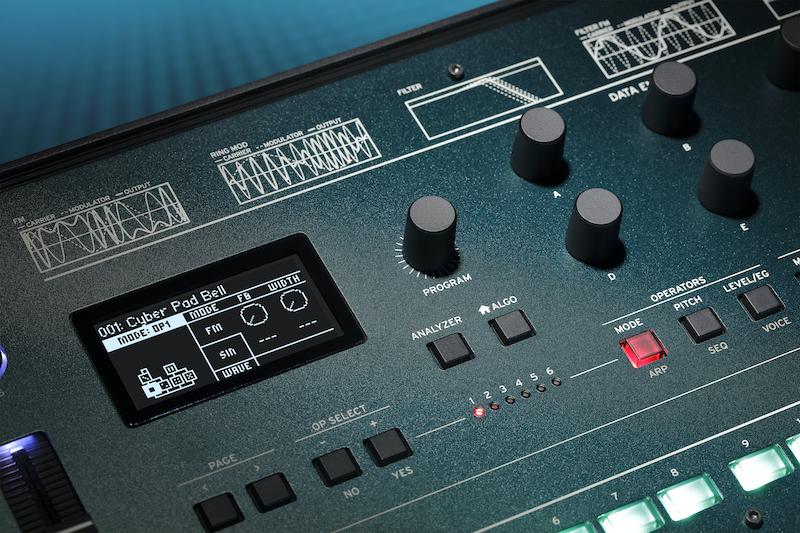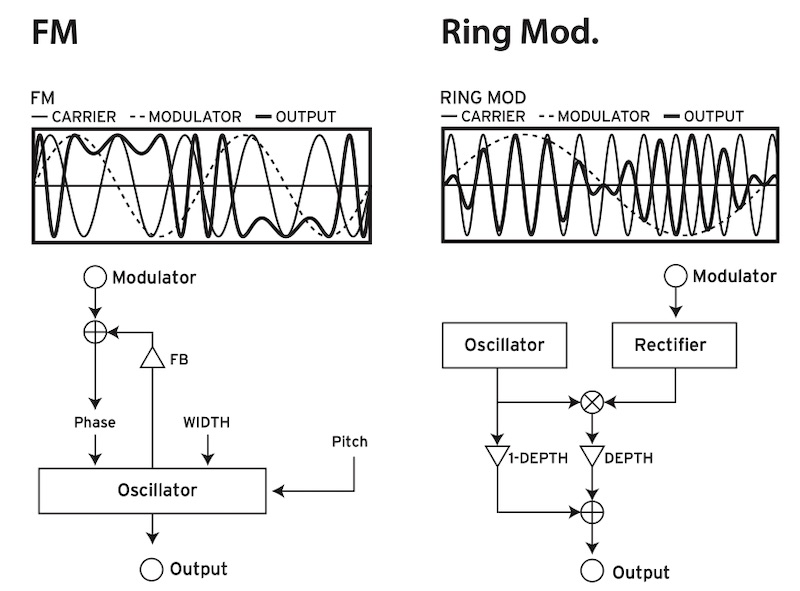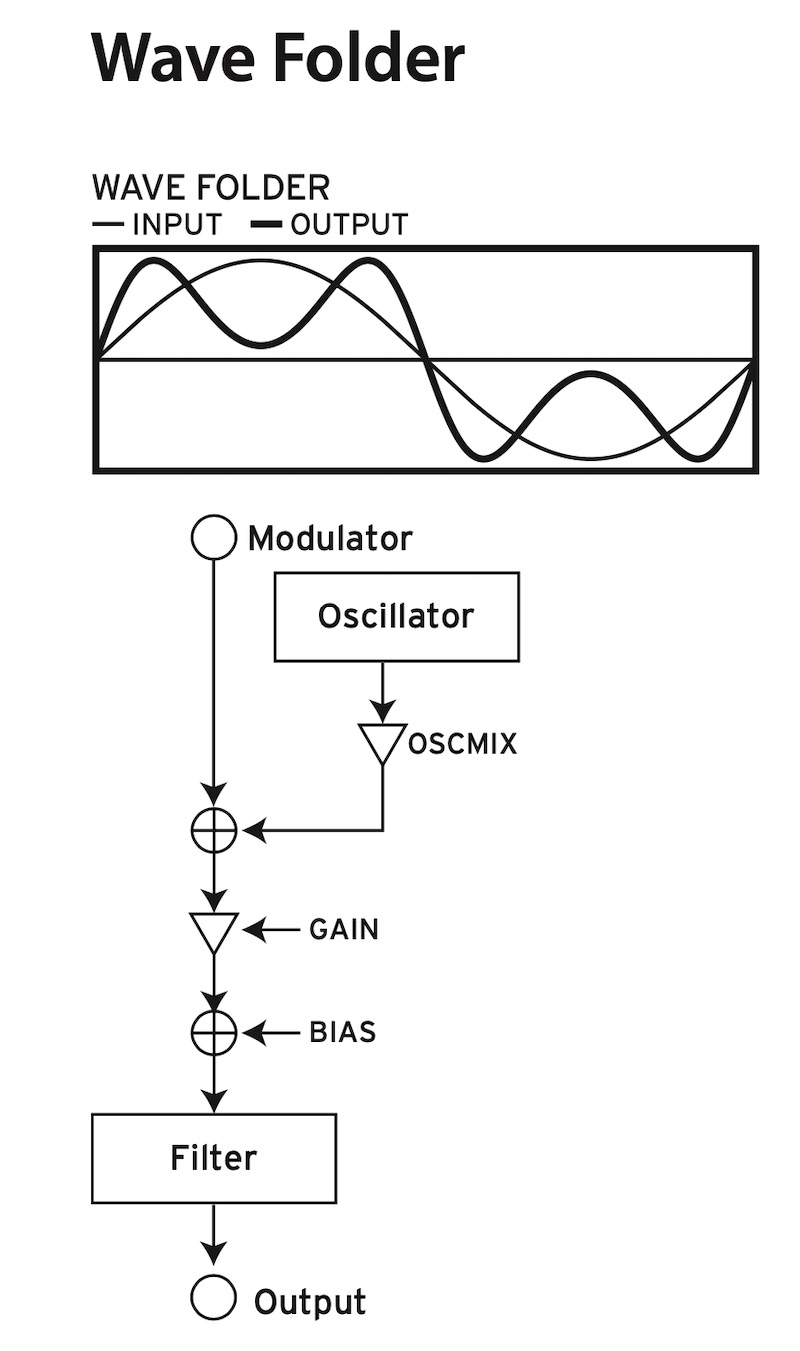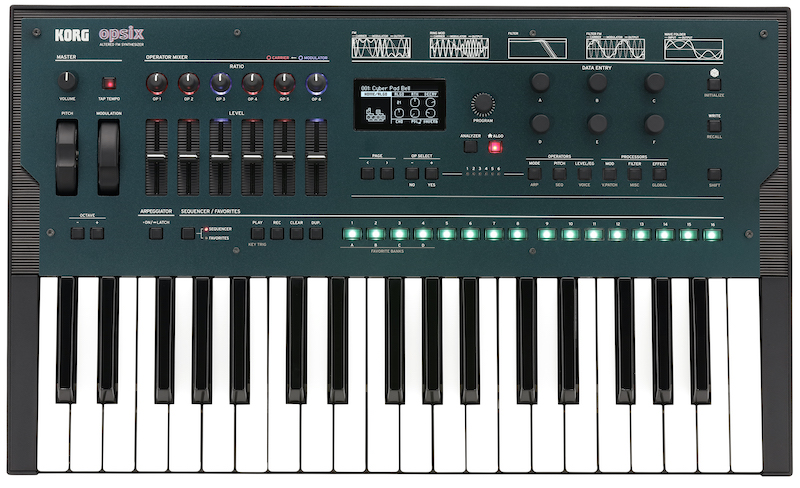The past couple of weeks have revealed a flurry of seeming product leaks from Korg—including the SQ64 sequencer and what looks to be a scaled-down version of the ARP 2600 (fulfilling a hope many have had since NAMM early this year). And while the hype surrounding the 2600 Mini has definitely been...well, let's just say "significant," another interesting product was revealed among these leaks: the Opsix.
Those who pay close attention to NAMM announcements might recall Korg showing a prototype/concept instrument called Opsix in January of this year—regrettably, nonfunctional and housed in a glass display. However, we're now happy to confirm that Opsix is real. In a Wavestate-sized package, the new Opsix Altered FM Synthesizer provides a significantly more hands-on approach to FM than most, and re-imagines what the sound and technique of an FM synth can be.
We've recently written some articles about FM technique and the history of FM synths—if you're not already familiar with FM, give those a read so that you can understand what makes the Opsix so special.
Korg's Opsix at a Glance
So, the Opsix is, as its name might imply, a six-operator FM synth. It features dedicated knobs for the frequency of each operator and dedicated sliders for the level of each operator—foregoing the heavily menu-based workflow of most FM synths by providing hands-on controls for these crucial parameters. The significance here can't be overstated: being able to reach directly into these key parameters and manually change them brings a unique set of performative options to the table. Additionally, LEDs provide backlighting for the knobs and sliders, using a simple color code to immediately reveal which operators are carriers and which are modulators in the presently selected algorithm. This along with an on-screen visualization of the algorithm at hand makes it super quick and easy to visualize the state of your current program—so for those of you left with a bad taste in your mouth by the programming and/or performance methods of a DX7...don't worry, this is an entirely different beast.
So yes, Opsix is a six-operator FM synth with hands-on controls for the most important parameters. But that's not the only place where the architecture differs from old school FM synthesizers—not even close. Opsix has up to 32 voices of polyphony, and features 40 preset FM algorithms and the option for user algorithms, making it far more customizable than the typical classic FM synthesizer. Moreover, the operators don't have to be sine waves: they can be any of 21 pre-set waveforms, with options for classic waveforms, bit-reduced sine waves, additive waveforms, multiple flavors of noise, and more. The oscillator section is followed by a filter with several distinct models for shaping each voice as a whole—and this combined with the rich variety of algorithms and oscillator waveforms makes it such that the Opsix can act as a quite convincing virtual analog synth.

The end of the signal chain include three effect slots, allowing for a wide range of modulation, distortion, and spatial effects. And of course, a rich modulation section makes it easy to animate a huge range of parameters. Each voice has three ADSR envelopes and three LFOs, with over 20 distinct LFO waveforms, including standard shapes, stepped triangle and saw shapes, and multiple options for randomness, including shapes with various degrees of randomness in terms of level and timing. With twelve modulation slots per program, crafting interaction in the Opsix is a deep and nuanced part of playing the instrument. This paired with six lanes of classic Korg parameter motion sequencing, a polyphonic step sequencer, and multi-pattern arpeggiator makes the Opsix one of the most playable FM synths to date.
Okay, so: six-operator FM with hands-on controls for operator levels and tuning ratios...tons of FM algorithms, and the ability to use any waveshape for each operator...extensive modulation...analog-modeled filters...loads of effects...note and parameter sequencing. That's already a heck of a synth. But there's still more beneath the hood in the Opsix—and in fact, perhaps its most distinctive feature is something we haven't touched on at all, the concept of operator modes. This is the territory where the Opsix most significantly diverges from other FM synths...and truthfully, from most other self-contained synths altogether.
So What is Altered FM Synthesis?
So, as we've said, each of the Opsix's voices has six operators. Operators can act as carriers and modulators, and can be arranged in a wide array of different configurations (or algorithms). That's how most FM synths work: they allow you to choose between different configurations of oscillators that all modulate one another. In the Opsix, things aren't always that simple: the behavior can vary significantly depending on your selection of operator modes. While most FM synths operate solely around the principles of FM synthesis, the Opsix reaches into the very core of the typical FM structure and reimagines how it could work by allowing operators to act in one of several capacities: in standard FM mode, or as a ring mod, filter, FM-able filter, or wave folder. That is altered FM in a nutshell.

In Korg's own words, "An Operator includes an input, an output, and an oscillator. The carrier's Operator mode determines how the oscillator is modulated by the input of the modulator." By choosing on an operator-by-operator basis just how the operator is meant to perform, you can combine synthesis techniques in an astonishing number of ways—creating everything from classic FM tones to subtractive sounds, Buchla-like wavefolded twangs, or even multiple layers of completely distinct types of sound. In FM mode, an operator works as you'd typically expect: it functions as an oscillator which can be modulated by a modulator (as determined by your algorithm). In Ring Mod mode, the operator's internal oscillator is multiplied with the modulator for classic ring mod tones. These two are simple enough to understand—but the others get a bit more complex.

In the Filter mode, the operator contains an oscillator and a multi-mode filter. The internal oscillator offers a mix control, allowing you to vary how much of its sound is sent to the filter. If a modulator is passed into a Filter operator, it is mixed together with the internal oscillator pre-filter. The filter's cutoff frequency is linked to the internal oscillator's pitch, but can be offset using the Cutoff parameter. This mode offers a wide range of filter types, including models of classic filters from the MS-20 and PolySix—each with variable cutoff and resonance. These provide a huge range of options, and can act in place of the downstream voice-level filter, allowing the option for rich, varied sonic layers. The Filter FM operator mode is similar, but rather than mixing the internal oscillator with an external modulator, the modulator instead modulate's the filter's cutoff frequency, creating an unmistakably aggressive, ripping/tearing sound typical of filter FM. By fine-tuning the modulator with the Filter FM operator's internal carrier, you can create everything from slowly shifting timbres to clangorous, obnoxious results.

The wave folder operator is a wave shaping effect similar to that found in many Buchla and Serge synthesizers, now known as a hallmark of what many people call "West Coast" synthesis. A wave folder adds harmonic content to simple sounds, turning sine waves into growling, nasal timbres with a distinct sonic character. In this operator type, an internal oscillator is mixed with external modulators and provided variable gain and bias, allowing you to alter the intensity and symmetry of the effect—somewhat like a distortion that warps simple waveforms into twisted, mirrored versions of themselves.
I've not yet gotten my hands on an Opsix, but all these different operator modes leave me very curious to hear how things one play out in algorithms that incorporate feedback—being able to introduce harsh feedback tones into a wave folder, for instance, can create a huge range of aggressive, edgy timbres—and perhaps running that result through a Filter FM operator could, for instance, yield some interesting results. Run in parallel with a typical FM stack or subtractive-style operator configuration, you'll surely be able to get all sorts of sounds not possible on most FM synths. I'm very curious to dive in to these features: on paper, it seems as if the options for creating custom algorithms, for defining operator behavior on an individual basis, and the ability to use the wide range of built in oscillator shapes for the operators is going to lead to everything from old-school glassy FM pads to pseudo-Virtual Analog sounds, Buchla-inspired West Coast tones, and, if all goes well, a wide variety of things we've simply never heard before.

Though it's not the full-size concept keyboard we saw at NAMM, I couldn't be more excited from this new offering from Korg. The Opsix checks all the boxes: on paper, it should be able to do most things you can do with a DX-7, but it also covers a huge amount of ground that most FM synths don't begin to approach. By allowing such flexibility at the level of the individual operators and algorithm configuration, it should be possible to create sounds that combine subtractive and FM approaches, that simultaneously harness harsh feedback, shifting filter FM tones, and soft, clean filtered waveshapes.
Many consider FM to have too distinctive a sound to use without evoking the 1980s. And while it can be difficult to break into new territory with FM instruments that still employ classic user interfaces, the Opsix seems to carry the promise of new territory—both through a cleverly expanded UI and through significant re-imagining of what can be done with the typical FM signal path. By opening up operators to do more than just FM, by allowing such a huge range of algorithms, and by giving the user so much control of modulation and direct parameter manipulation, I'm sure that the Opsix will do much more than just bring back DX7 sounds. Personally, I can't wait to play one.











